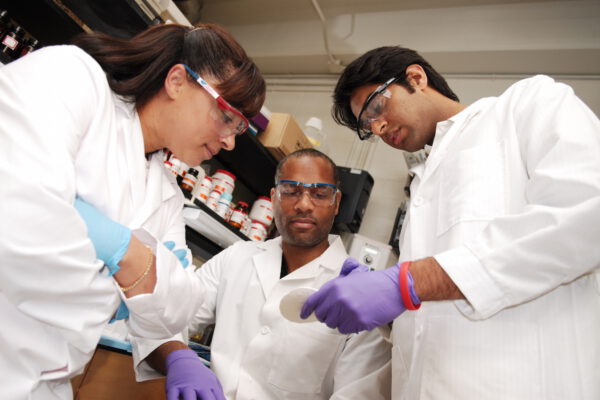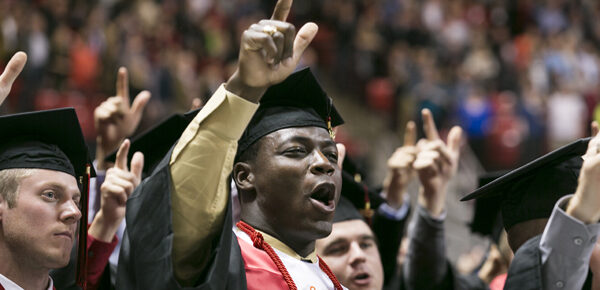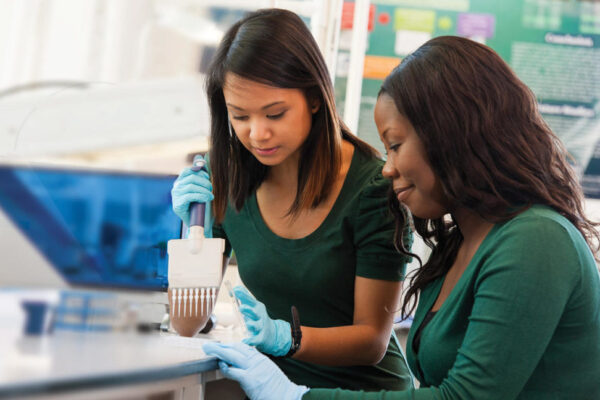By W. Carson Byrd
This post is the second in a series on campus climate and STEM success. ACE is partnering with the National Center for Institutional Diversity at University of Michigan on the series.
The success of underrepresented minority students in higher education, particularly in science, technology, engineering, and mathematics (STEM) fields, often takes central focus in discussions of the entrenched disparities on our campuses. In a recent project, I examined data from the National Longitudinal Survey of Freshmen, which includes information on the college experiences of 4,000 students at 28 highly selective U.S. institutions. The data provide insights into students’ lives from the time they enter college until they graduate. I examined factors influencing students’ social interactions during college, and how these interactions subsequently influenced their racial ideologies (i.e., frameworks for explaining or rationalizing race and inequality in society) when they graduated. The analyses show how students’ social interactions and views of race and inequality are shaped by the campus climate, which could explain some of the STEM disparities we see at our institutions.
Who do students interact with during college?
As the findings in Figure 1 suggest, students interact infrequently across racial and ethnic lines during their time in college. Each bar represents the odds ratio of two students from each group interacting with one another compared to interacting with peers from their same racial or ethnic group. The bar for the likelihood of white and black students interacting during college indicates that these students are 87 percent less likely to interact across racial ines with each other compared to interacting with same group peers. That is, there is only a slight chance these students will form meaningful relationships during college. As a whole, white students were the least likely to interact outside of their own group; black, Latinx, and Asian and Pacific Islander students were more likely to interact with one another, though they were still less likely to have interracial (across group) than intraracial (within group) interactions during college.

How does the campus climate impact students’ interactions?
Long-standing research describes the importance of campus climates, suggesting students’ college experiences may reflect these climates in varying ways. My research included two campus climate measures. The first measure included the (1) frequency students felt self-conscious; (2) heard derogatory remarks; and (3) were discriminated against by faculty, staff, and students because of their race or ethnicity. The second measure asked students how much students felt their institutions were committed to diversity (ranging from too little to too much).
As the findings show, all students, including whites to a lesser degree, were impacted by perceiving their campuses as racially hostile spaces. Some of these effects on students’ experiences were positive, while others were not. For all students, racially hostile campus climates increased their interactions with students of color on campus, particularly black students, but also somewhat reduced the frequency of interactions with white students. Students’ perceptions of their institutions’ commitment to diversity influenced their interactions less than their perceptions and experiences of racial hostility on campus, but did so particularly for how frequently white and black students formed friendships with one another on campus. White students who perceived their institution as doing more to promote diversity on campus formed more friendships with black peers during college. However, black students who perceived the same level of institutional commitment to diversity formed fewer friendships with white peers. Thus, these findings provide an example of the complexity of how perceptions of campus climates can influence students’ interactions with one another.
Why complicate how we think about colleges in relation to race and student experiences?
Highly selective colleges are competitive environments without question. However, we must consider that nearly all of these institutions operate as historically white colleges and universities, privileging the opportunities and experiences of white students for which they were founded generations ago (e.g., the work of Craig Steven Wilder, Eduardo Bonilla-Silva, and David L. Brunsma and colleagues, among many others). Additionally, Natasha K. Warikoo found that elite college students, particularly white students, emphasize narrow views of meritocracy to understand resources and opportunities shaping racial inequalities—they claim that it’s a color-blind system of achievement mainly reflecting a person’s efforts. These students also believe their grades are the result of their own efforts, not an amalgamation of circumstances since birth shaping their opportunities to pursue degrees at prestigious institutions. These views limit their understanding of why a classmate may be at a disadvantage despite sitting next to them in the classroom. Racial discrimination, including microaggressions, is set aside as an exception to the view of highly selective institutions as mostly functional meritocratic organizations rewarding the “best and brightest.”
With this context in mind, a long history of research on intergroup relations has found that interacting across racial and ethnic lines can reduce racial prejudice and individualistic explanations about racial inequality, under particular conditions. Does this hold for students at these highly selective institutions? The short answer: it’s complicated. One-third of students’ social interactions during college reduced their prejudicial views or beliefs that racial inequality was mostly the result of a person’s individual efforts, while one-sixth of these social interactions actually increased these views—so half the time students’ social interactions did not influence their racial ideologies.
Campus climate is a vital part of this story: Students who perceived their campuses as more racially hostile were more prejudiced toward one another. They were also more likely to support individualistic views of racial inequality—that it’s mainly the result of individual efforts, eschewing structural inequality. On a related note, if they viewed their institutions as being too committed to diversity, they were more supportive of individualistic views of racial inequality. So a hostile campus climate divides students both through their social interactions and how they understand race and racism on campus and in broader society. This situation can frame racial discrimination incidents as “teachable moments” about how individuals should not act, while dismissing these incidents from the endemic reality of students of color in their everyday lives on these campuses.
What does all of this have to do with tackling disparities in STEM?
Subsequent research in a second project examining how campus climates can influence black students’ STEM pursuits at these same institutions found that students who perceived a more racially hostile campus climate were less likely to complete a STEM degree despite initially pursuing it. Those students who stayed in STEM programs exhibited the debilitating effects of John Henryism on their academic performance, in which they worked so hard to combat the psychological distress of the racially hostile campus climate and stereotype threat that their grades dropped in comparison to black students who transferred out of STEM fields. This is the pernicious reality of how racism on our campuses submarines black students’ academic success.
The cultural and structural features of their institutions, which include campus climate, inform students’ navigation of their campuses. Students’ social interactions can provide support and resistance to racially hostile campuses, but they can also reinforce narrow perspectives of merit and effort in highly competitive academic environments. If a campus is marked by racial hostility and students are slowly pulling away from one another and are not considering their peers’ situations, what happens when subtle experiences occur frequently enough to become the norm for what underrepresented minority students endure in hyper-competitive, racially hostile STEM programs? How many negative situations go unquestioned or swept under the rug, with the student simply being dismissed as “hypersensitive?”
And so we have to ask: If students are disconnected from one another, how likely are they to identify that academic success can be impacted by factors beyond their own individual efforts? What about understanding how racial inequality persists outside of college in their lives or the different careers they pursue, such as in STEM fields? Until we tackle our campus climates, including the cultural and structural realities that influence how students interact with one another, attempting to make STEM programs more equitable will continue to run into obstacles.
If you have any questions or comments about this blog post, please contact us.


